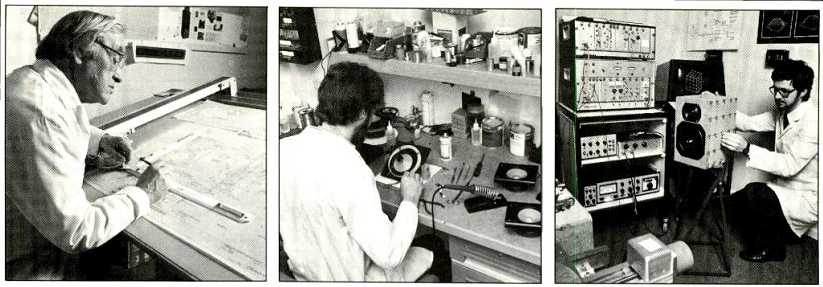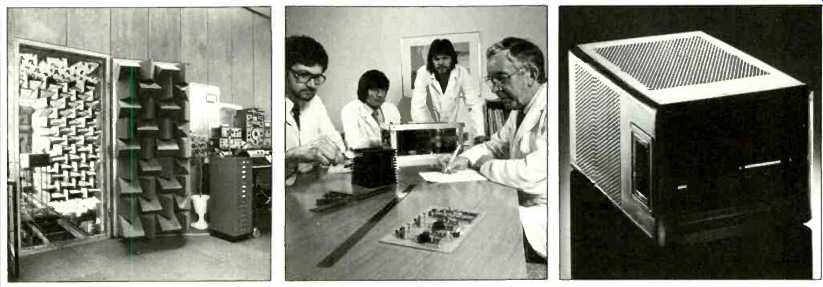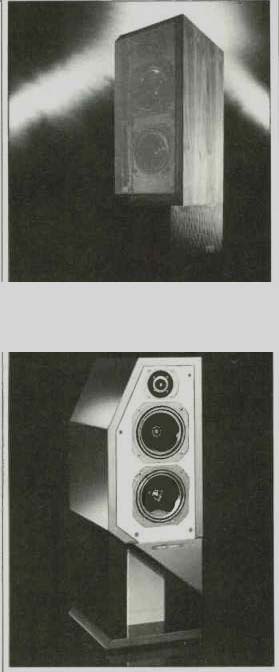MODERN ENGLISH

above (L-R): B & W's car speaker on the drawing board of J. R. Greenwood;
Constructing drivers used in the B & W Modular Automobile Sound System;
G. J. Adams setting up laser interferometer test of cabinet resonance
Who was it that said, "Oh, to be in England now that spring is here"? Happily, this quote was quite apropos for a recent trip I took with Associate Editor B. V. Pisha to the B & W Loudspeaker facilities in Worthing, Sussex. Instead of the usual rain and gray bluster, the sun shone brilliantly, the grass was green, the willows were weeping and the lilacs were blooming. Needless to say, such an opportunity to go "behind the scenes" (plug intended) is much appreciated.
Being able to meet the designers and engineers of audio products and ob serve fabrication, measurement, and quality control is always fascinating, instructive, and rewarding.
Since I last visited, in April 1980, B & W has gained a significantly larger share of the high-quality loudspeaker market. The acceptance of their Model 801F as the preeminent monitor for classical music recording by the major record companies has been well documented. Now the mighty Model 808 (discussed here in March 1985) is rapidly becoming the monitor of choice to cope with the high power-handling exigencies of digital recording.
B & W has prospered from the success of their loudspeakers for the consumer market, and all this growth and activity has necessitated considerable expansion of their manufacturing facilities. B & W is one of the most re search-oriented companies in loudspeaker manufacturing. By centralizing all of their research and development work in Steyning, a small village six miles north of Worthing, they have gained much manufacturing capacity in their original plants.
The ever-genial chairman John Bowers, company president Peter Hay ward, and the irrepressible international marketing director Robert Trunz took us to the Steyning research establishment. Here, B & W maintains a large anechoic chamber and laboratories lavishly equipped with all sorts of exotic Tektronix and Bruel & Kjaer oscilloscopes, signal generators, graphic recorders, FFT analyzers, Time Delay Spectrometry equipment, and other instruments too numerous to mention.
B & W pioneered the use of laser interferometry for analysis of vibratory modes in loudspeaker cones and drivers, and their laser interferometer has been further refined. Now housed in a separate temperature- and humidity-controlled room, it is linked to a more modern high-density computer which has extensive graphics for visualizing various test data. The Steyning facility also has a special, acoustically treated listening room, plus a "normal" listening room supposedly representing the kind of environment found in most homes. It was our opinion that the latter was rather more stark and reflective than most American living rooms.
Ongoing tests and studies conducted by John Bowers and his staff of engineers at the Steyning research establishment have resulted in several new product developments, including their first active loudspeaker, the Active 1. This is the initial model in a projected line of such loudspeakers, and a separate new company, John Bowers, Ltd., has been set up to market them. (Like B & W speakers, they will be imported to this country by Anglo-American Audio.) The Active 1 has three vertically in-line drivers, with electronic inter-unit time-delay correction. Treble is handled by a 26-mm, polyamide, laser-optimized dome tweeter. The bass and bass/midrange drivers are both of Bextrene, with edge-wound ribbon voice-coils on Kapton formers, and can operate safely at up to 250° C.
The electronics-amplifiers, crossovers and contour controls for bass and treble-are mounted in an isolated compartment at the back of each loud speaker cabinet. The 200-watt bass amplifier, using vertical MOS-FETs, powers the bass and bass/midrange units, while the tweeter is powered by a similar amplifier of 100 watts output.
Both amplifiers operate in Class A up to the first 90 dB of acoustical output; beyond that point, they operate in Class AB.

above (L-R): Anechoic chamber and test instruments in Steyning research establishment;
Testing of the John Bowers MPA1000 amp; Mr. Bowers is at extreme right;
Prototype of the MPA1000 amp, which puts out 1 kilowatt/channel into 4
ohms

top: John Bowers Active 1 loudspeaker; above: the Active 1 Limited
The Active 1 has Automatic Overload Protection Circuits and an automatic on/off a.c. switching system activated by the presence of a signal.
The loudspeaker drivers and the electronics are housed in a 28-liter en closure made of a very rigid, low-resonance, high-density particleboard and bitumen compound laminate. The enclosure measures 24 5/8 in. H x 14 in. D x 10 in. W and is integrated into a pedestal-type stand for an overall height of 33 7/8 inches. The Active 1 is available in black ash, natural oak, and walnut veneers. A special version, the Active 1 Limited, has an unusual, very modernistic asymmetrical enclosure, and is sold in mirror-image pairs finished in black or red lacquer.
We auditioned the Active 1 in the "normal" listening room and agreed that the acoustics of this room were too reflective to permit a truly representative evaluation. I have an LEDE (live end/dead-end) listening room in my home, so perhaps I am unduly sensitive to underdamped rooms. In any case, when the Active 1 loudspeakers were set up in the acoustically treated listening room, it was easy to perceive the very high order of musical realism provided by their unique design. With 300 watts of power per channel properly apportioned among the three drivers, they gave a very convincing demonstration of their capabilities with digital recordings of wide dynamic range.
The imaging was impressive, stable and precise, with a good sense of depth affording a spacious dimensionality to the music.
The expected advantages of this type of design in respect to transient response and intermodulation distortion were fully realized. All manner of percussion-drums, cymbals, wood block, bells-and piano transients had an incisive attack and were very clean.
Bass response extends down to 32 Hz, thanks to low-frequency equalization employing active filters. Tympani, kick drum and contrabass viols, therefore, were well reproduced, although not with the weight and authority of a Mod el 808. Smooth, non-peaky response from high strings and soprano voices attested to the evenness of frequency response.
With a wide variety of pop and classical music, the Active 1 is unquestionably a good performing loudspeaker.
And for those who desire a "big sound" but cannot afford the space or the cost of 801F or 808 speakers, it is a reasonable alternative. Projected cost in the U.S. will be $2,995 per pair. Of course, another advantage of this design is its neatness and compact size-all one need do is add a good-quality preamplifier, and it's ready to perform. To this end, there is an optional, companion Active Control Unit ($775). This is a rather basic, high-quality preamp with both MC and MM phono inputs, high-level inputs, and volume and other operating controls.
Another new product demonstrated at the research establishment, the MPA1000 power amplifier, is a further example of John Bowers' aggressive move into electronics. A MOS-FET de sign embodying new and proprietary technology, this brute has a gargantuan output of 1 kilowatt per channel into 4 ohms! Driving a pair of Model 808s in the damped listening room, the prototype amplifier made a most favor able impression, with obvious ease of high power output. On pop/rock material, the impact was visceral. On large scale classical recordings, the weight and sonority of contrabass, tympani, bass drums and organ sounded most convincing and authoritative. High strings and upper-register brass were smooth and sweet, without a trace of harshness or edginess.
We were also given a demonstration of how laser interferometry is used to plot the resonant modes of enclosure panels and to retest them after corrective damping and bracing have been applied. We listened to a test of three identically sized enclosures constructed of different materials but which had identical drivers. One of the enclosures was made of the material currently used in B & W cabinets. Another was made of a much-touted honeycomb material, and one was made of a high-density proprietary material which may be incorporated in future B & W loud speakers. The test signal was low-level music with a superimposed high-intensity transient signal that sounded like a wood block. The difference in the sounds from the three enclosures was striking. It was easy to perceive a small amount of resonant coloration from the standard B & W enclosure material, and a bit more coloration--of a more peaky nature--from the honeycomb material. The new material was almost totally free of resonant colorations.
Back at the Worthing plant, after having seen the manufacture of various parts, the winding of voice-coils, and assembly and quality-control procedures on all B & W loudspeakers up to the 808, we proceeded to the parking lot. There we heard B & W's new MASS (Modular Automobile Sound System), a group of bass, midrange, and high-frequency modules which permit great flexibility for mounting into the myriad of different car models. One can start with the basic modules, add 801F-type tweeters, and go on all the way to a trunk-mounted subwoofer.
A pair of the basic modules were mounted on the door panels of John Bowers' Porsche 944. These door-mounted modules have a proprietary dispersion device to direct their sound up into the car interior. They are very rugged, with Kevlar cones and exceptionally large magnet structures, and are even fitted with B & W's Automatic Protection Overload Circuit. Sitting in the luxurious bucket seat of the Porsche, and listening to pop and classical music from a Nakamichi cassette deck, I was really impressed with the effortless high power, cleanness and good bass response. The most unusual thing was that the dispersion device created a broad panorama of sound right above the dashboard, seemingly on the windshield of the Porsche. I think this MASS product is going to cause quite a stir in the American car stereo market.
There were numerous other interesting products and demonstrations at B & W. As always, John Bowers, Peter Hayward and Robert Trunz were the most gracious of hosts, with boundless hospitality. It was nice to receive the good fellowship of such progressive people, who so obviously enjoy the work that they do.
While in Steyning, we were invited to the home of the urbane Alastair Robertson-Aikman, owner of SME, the well known manufacturer of high-quality tonearms. (The building which now houses the B & W Steyning research establishment used to belong to SME.) Alastair is the quintessential English gentleman, and on the occasion of my last visit, in 1980, I described his fabulous, purpose-built listening room with its 30-ton, reinforced-concrete roof! Gone now are the multiple-unit Quad Model ESL loudspeakers, replaced by Quad ESL-63s, each damped by 80 pounds of added mass. Alastair is very big on opera, and fellow opera-lover B. V. Pisha was simply overwhelmed when Alastair played the Carlos Kleiber recording of Die Fledermaus for him. Dr. Pisha says that the truly marvelous acoustics of this room afforded the most realistic presentation of recorded opera he had ever heard.
Alastair played this recording using his new tonearm, an all-out design with several pieces of new technology. For example, the arm and headshell are cast in one piece and of a special alloy. Such high-precision casting is hard to find, and I was interested to learn that Alastair has this work done for him by a master artisan in Chicago, who then ships it to England where the complex machining is done in the SME plant. There is no doubt that this arm is jewel-like in its finish and fairly exudes a high-tech appearance. It will be distributed in the U.S. by Dave Fletcher's Sumiko Company, and is expected to sell for $1,500.
(adapted from Audio magazine, Bert Whyte)
= = = =